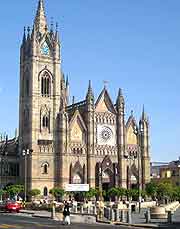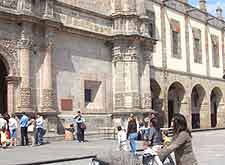Guadalajara History Facts and Timeline
(Guadalajara, Jalisco, Mexico)

It took Spanish conquistadores three attempts to establish a permanent settlement in what is now Mexico's second-most populated city, Guadalajara. Little is known about the area's pre-European history and population, but at least 15 different languages were spoken in the region before conquistador Nuno de Guzmán's 1542 arrival.
The first Spanish settlement near present-day Guadalajara was abandoned because of lack of water. Early Spanish colonists moved from the area to near Tonala, and then to Tlacotán. The formerly peaceful Tlacotán tribes attempted an uprising against Guzmán after he and his followers pillaged and burned their way through the tribe's land.
Mixton War
The Mixton War between 1540 and 1542 further postponed Guzmán's aspirations of creating a permanent city, which he planned to name after his Spanish hometown of Guadalajara. Guzmán died in a Spanish prison before Guadalajara was officially established as a city. This only occurred after its final move to a site known as Atemajac, where Guadalajara still stands to this day. Today, a monument honouring original governor Cristóbal de Onate and Dona Beátriz de Hernández stands on the Plaza de Los Fundadores.
Mexican War of Independence
Guadalajara's first cathedral was built in 1561, but it has undergone at least half a dozen renovations due to earthquake damage in subsequent centuries. By 1667, the city grew to encompass at least four small towns and villages.
In 1811, Guadalajara became a major Mexican Independence War battlefield after Miguel Hidalgo y Costilla, a leader of the independence movement, sought refuge in the city. A gigantic Hidalgo statue now sits near the oldest surviving theatre on the Plaza de la Liberacion.
During Hidalgo's stay, he established a pro-revolutionary newspaper and signed a proclamation to abolish slavery. Despite Hidalgo's presence, however, Guadalajara remained under royalist control until near to the war's end in 1821. The city became Jalisco's state capital after Mexican independence was achieved.

Growing Pains
Guadalajara continued to be a volatile city following Mexican independence, a period in history which saw the Revolution of the Three Hours exile one president and establish another. The city briefly became Mexico's government seat during the 1856 Reform War and French troops occupied the city during the 1864 French Intervention.
The 19th century, when the city grew to become Mexico's second largest, was a time of rapid growth. Guadalajara became a significant rail link between the United States and the Pacific Coast, and electricity arrived between 1884 and 1890. Of note, Guadalajara's observatory was established in the late 19th century.
Modern-Day History
Guadalajara experienced a substantial growth spurt during the 1930s and opened its first industrial park in 1947. Migrants from throughout Mexico flocked here between the 1940s and the 1980s, to work at the city's electronic companies. In 2007, FDI magazine named Guadalajara not only Latin America's most business-friendly city, but also the North American city with the second-strongest economic potential behind
Chicago.
No matter how much Guadalajara has grown and been modernised, its stately downtown area remains its greatest tourist attraction, especially around the Plaza de Armas. Police guard the plaza's French Ironwork bandstand, a popular political protest spot. The smaller triangular Plaza de los Mariachis is the best place to enjoy the famous Mexican music originating from Guadalajara. Jarabe Tapatio dancing, otherwise known as the Mexican hat dance, accompanies this lively music.
 It took Spanish conquistadores three attempts to establish a permanent settlement in what is now Mexico's second-most populated city, Guadalajara. Little is known about the area's pre-European history and population, but at least 15 different languages were spoken in the region before conquistador Nuno de Guzmán's 1542 arrival.
It took Spanish conquistadores three attempts to establish a permanent settlement in what is now Mexico's second-most populated city, Guadalajara. Little is known about the area's pre-European history and population, but at least 15 different languages were spoken in the region before conquistador Nuno de Guzmán's 1542 arrival.